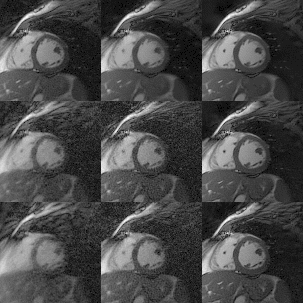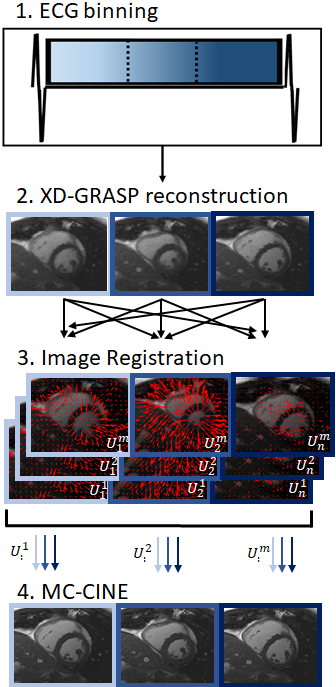Gastao Cruz1, Kerstin Hammernik2,3, Thomas Kuestner1, Daniel Rueckert2,3, René M. Botnar1, and Claudia Prieto1
1School of Biomedical Engineering and Imaging Sciences, King's College London, London, United Kingdom, 2Technical University of Munich, Munich, Germany, 3Department of Computing, Imperial College London, London, United Kingdom
1School of Biomedical Engineering and Imaging Sciences, King's College London, London, United Kingdom, 2Technical University of Munich, Munich, Germany, 3Department of Computing, Imperial College London, London, United Kingdom
Conventional cardiac CINE imaging relies on highly ill-posed motion resolved reconstructions
from data acquired across several heartbeats. Here, we propose a jointly
regularized motion corrected framework that uses all the data for every cardiac
phase, enabling one-heartbeat CINE.

Fig.4 Animated CINE for a third representative
subject reconstructed with iterative SENSE (column 1), XD-GRASP (column 2) and the proposed MC-CINE (column 3) using 20 heartbeats (row 1), 2 heartbeats (row 2) and 1 heartbeat (row 3). The dynamics of the cardiac contraction are captured
in every case, however considerable streaking and noise amplification are
visible for XD-GRASP and especially iterative SENSE at higher accelerations.
MC-CINE with 448 spokes (1 heartbeat) achieves comparable image quality to
iterative SENSE and XD-GRASP with 8960 spokes (20 heartbeats).

Fig.1
Diagram of the proposed approach (considering here only three cardiac phases).
1) Acquired data is retrospectively binned into multiple cardiac phases. 2)
Preliminary cardiac resolved images are obtained via XD-GRASP. 3) Each cardiac
phase is registered to every other cardiac phase to estimate the cardiac motion
between all phases. 4) The estimated motion is incorporated into the proposed
MC-CINE to reconstruct each cardiac phase as a motion corrected image from all
the data.
